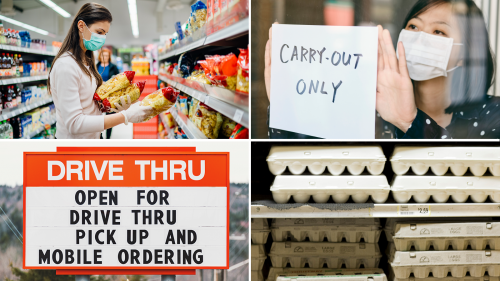FDA Provides Flexibility to the Food Industry to Support Food Supply Chain and Meet Consumer Demand During COVID-19

By: Susan Mayne, Ph.D., Director, Center for Food Safety and Applied Nutrition
During these turbulent times of the coronavirus (COVID-19) pandemic, our daily lives have changed, and consumers are understandably worried about what kind of, and how much food is available to feed themselves and their families. We have no nationwide shortages of food, thankfully, but we are seeing a shift in demand for certain foods and other goods that are leading, at times, to temporary shortages on supermarket shelves and other places where consumers shop. The reasons for this shift are varied. Restaurants may be closed or limited to take-out or delivery only, schools and hotels are closed, and many of us are cooking more at home. This has resulted in an imbalance in the food supply chain with excess quantities of food typically supplied to restaurants and other food service establishments and increased demand for food supplied to supermarkets.
It’s important for you to know that the U.S. Food and Drug Administration is aware of these issues and doing what we can to help. We are working closely with the food industry and with the U.S. Department of Agriculture to provide flexibility regarding federal food labeling and other requirements when possible, so consumers have access to the food they want.
To achieve that goal, the FDA has issued temporary guidance that provides flexibility to various segments of the food industry—restaurants, food manufacturers, producers and retail establishments—to help support the food supply chain and meet consumer demand in this time of crisis.
Nutrition Labeling
As a first step, we continue to provide temporary flexibility regarding nutrition labeling requirements for certain packaged foods during the COVID-19 pandemic. We have heard that restaurants and food manufacturers have food delivered to them that they are not able to use right now. That food is not labeled the same as it would be for sale to consumers in a grocery store. Rather than waste this excess food, businesses would like to redirect it for sale to consumers. To make this possible, late last month we issued new guidance indicating that the FDA, under certain conditions, will provide flexibility for restaurants and food manufacturers to sell packaged food (both perishable and non-perishable) that lacks a Nutrition Facts label to consumers directly, or to other businesses for sale to consumers. Information will be present to help ensure, for instance, that food can be traced back to its source in the event of an outbreak of foodborne illness and that consumers with food allergies or intolerances can identify the presence of such ingredients in the food.
The first compliance date for the new updated Nutrition and Supplement Facts labels was January 1, 2020. While many companies are already meeting the new requirements, we have heard that some need more time to change their labels. Therefore, the FDA will continue to work cooperatively with manufacturers for the remainder of this year to help their transition rather than focusing on enforcement actions during this time.
Menu Labeling
We also are providing flexibility when it comes to chain restaurants and similar retail food establishments covered by our menu labeling requirements, which we implemented in May 2018. Our regulations require that these covered establishments provide nutrition information, including calorie declarations, for standard menu items at the point where consumers make a selection. Earlier this month, we issued new guidance providing flexibility to covered establishments that may not be able to meet these requirements for the duration of the public health emergency related to COVID-19.
We recognize that meeting these requirements would be difficult for businesses that are temporarily changing their practices as a result of the pandemic. For example, some dine-in operations are rapidly switching to take-out only, which may require changes in online ordering portals and printed menus. Additionally, some of these establishments may be experiencing temporary disruptions in their food deliveries, which may lead to having different menus or making substitutions that could affect the accuracy of the nutrition information for standard menu items.
Shell Eggs
During this pandemic, we have learned that people want to buy more eggs. So, we also issued temporary guidance to address the increasing consumer demand we are seeing for shell eggs sold at supermarkets or retail establishments. The first of two guidance documents addresses packaging and labeling. The industry has enough shell eggs available but not enough retail packaging that is appropriately labeled according to our requirements. This is because normally many eggs that are produced go directly to restaurants and other large-scale food service institutions, and labeling and some packaging requirements are different for those eggs. For example, some of the available eggs are packaged in flats that typically hold 30 eggs. Now that many restaurants and other food service operations are closed, we want to provide flexibility for them to sell those eggs on flats or in other packaging directly to supermarkets and other retail locations.
While this temporary packaging for shell eggs may look different to consumers, we are providing flexibility for certain information, such as the name and address of the manufacturer, packer, or distributor, to be displayed at the point of purchase. Providing this information is important because, in the event of an outbreak of foodborne illness, it helps enable food to be traced back to its origin. Safe handling instructions will still be present, which are required for shell eggs that have not been processed to destroy all Salmonella. The instructions tell consumers to keep eggs refrigerated, cook eggs until yolks are firm, and cook foods containing eggs thoroughly. Food safety is paramount, and we must continue to protect consumers. Yet to provide flexibility, consumers may see this information displayed on a counter card, sign, or tag rather than directly on the packaging.
Another action we are taking to meet the demand for shell eggs is to provide producers of eggs that normally would be sent to facilities for processing into egg products—typically used in restaurants—the flexibility to sell their eggs for distribution to retail locations, such as supermarkets, when certain conditions are present. Under our temporary policy, we are providing flexibility for shell eggs that normally would be further processed into egg products, such as liquid whole eggs, to be sold directly to retail locations when certain conditions are met. Additional information about this temporary policy can be found in this guidance.
We at the FDA have one central goal in mind when taking these temporary actions—to help ensure that food is safe, plentiful and available for consumers. We will continue to work closely with our government partners and with industry to monitor and take future action to help support the food supply chain during this time. We are all in this together!

